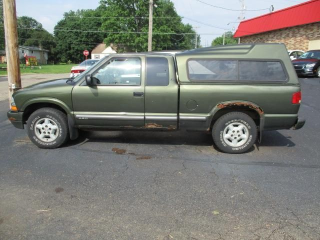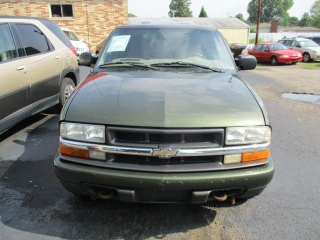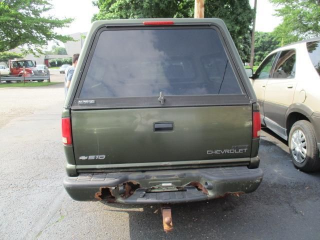The 2001 Chevrolet S-10 is a quintessential compact pickup truck, part of the second generation (1994-2004) that solidified its reputation for utility and versatility. Available in Regular Cab and Extended Cab (including a unique third-door option), with both 2WD and 4WD, it offered various configurations. Key trims included Base, LS, the off-road capable ZR2, and the sporty Xtreme. New prices ranged from approximately $13,000 to $25,000. Its enduring popularity stemmed from its practical size, affordability, and "get-the-job-done" attitude.
The Good
The 2001 S-10 boasts robust powertrains, offering reliable performance for daily tasks and light hauling. Its practical, no-nonsense design and comfortable, functional interior appeal to those needing a capable work vehicle. For emotional buyers, it offers a sense of rugged utility and nostalgia, while practical buyers appreciate its excellent value, reasonable fuel efficiency (especially with the 4-cylinder), and straightforward maintenance, making it an economical long-term choice.
The Bad
Owners should watch for several common issues with the 2001 S-10. These include potential fuel pump failures, leaking intake manifold gaskets on the V6 engine, and premature wear of ABS sensors. Rust can be a significant concern, particularly on brake lines and the frame in salt-belt regions. Other points of concern are sometimes noisy brakes, electrical glitches, and worn suspension components.
2001 Chevrolet S-10: Quick Overview
Here is a summary of the 2001 Chevrolet S-10's key specifications:
- Engine Options:
- 2.2-liter OHV (Overhead Valve) 4-cylinder engine (L43)
- 4.3-liter OHV V6 "Vortec" engine (L35 or LF6, depending on configuration)
- Horsepower:
- 2.2L I4: Approximately 120 horsepower and 140 lb-ft of torque.
- 4.3L V6: Approximately 180-190 horsepower and 245-250 lb-ft of torque (depending on 2WD/4WD setup).
- Fuel Economy (EPA estimates vary by configuration):
- 2.2L I4 (2WD, manual): Around 20 MPG city / 26 MPG highway.
- 2.2L I4 (2WD, automatic): Around 19 MPG city / 24 MPG highway.
- 4.3L V6 (2WD, manual): Around 17 MPG city / 23 MPG highway.
- 4.3L V6 (4WD, automatic): Around 15 MPG city / 19 MPG highway.
- 0-60 MPH Times:
- 2.2L I4: Roughly 10-12 seconds.
- 4.3L V6: Roughly 8-9 seconds, offering more spirited acceleration.
- Towing Capacity:
- Max towing capacity can reach up to approximately 5,500 pounds when equipped with the 4.3L V6 engine, appropriate axle ratio, and a towing package.
- Minimum towing capacity with the 2.2L I4 engine is around 2,000 pounds.
- Trim-Level Features:
- Base: A no-frills work truck, typically featuring vinyl seating, manual windows and locks, and an AM/FM radio. Focused on essential utility.
- LS: Adds more comfort and convenience with cloth upholstery, air conditioning, power steering, and an AM/FM/CD stereo. Optional features included power windows, power door locks, power mirrors, and cruise control, along with chrome exterior accents.
- ZR2 (Off-Road Package): A highly capable off-road variant. It featured a unique wider frame, larger off-road tires, upgraded suspension with Bilstein shocks, skid plates for underbody protection, and increased ground clearance. This trim almost exclusively came with the 4.3L V6 and 4WD.
- Xtreme (Sport Package): Focused on a sporty appearance and handling. Included a lowered sport suspension, body-color grille and bumpers, ground effects, unique alloy wheels, and special badging. Often came with bucket seats and was primarily RWD.
2001 Chevrolet S-10 Specifications
Vehicle Information
| Year | 2001 |
| Make | Chevrolet |
| Model | S-10 |
| Trim | - |
| Style | Extended Cab 4WD 4-Speed Automatic |
| Type | Pickup Truck |
| Category | Small Pickup Truck |
Manufacturing Details
| Made In | United States |
| Manufacturing City | SHREVEPORT |
Dimensions
| Doors | 2-Door |
| Curb Weight | 3750 pounds |
| Gross Vehicle Weight Rating | 5150 pounds |
| Overall Height | 63.40 inches |
| Overall Length | 204.80 inches |
| Overall Width | 67.90 inches |
| Wheelbase Length | 122.90 inches |
| Standard Seating | 4 |
Engine & Performance
| Engine | 4.3-L V-6 OHV 12V |
| Engine Size | 4.3L |
| Engine Cylinders | 6 |
| Transmission | 4-Speed Automatic |
| Transmission Type | Automatic |
| Transmission Speeds | 4-Speed |
| Drivetrain | Four-Wheel Drive |
Additional Features
| Anti-Brake System | 4-Wheel ABS |
| Steering Type | Recirculating |
Pricing
| Manufacturer Suggested Retail Price (MSRP) | $19,321 |
| Invoice Price | $18,258 |
| Delivery Charges | $585 |
Vehicle History Report
Specifications
History
Events
History Check
Check
Check
Check
Check
Listings
Recalls
Check
Analysis
What Problems Does the 2001 Chevrolet S-10 Have?
The 2001 Chevrolet S-10, while generally robust, does have several frequently reported problems and long-term reliability concerns owners should be aware of:
- Fuel Pump Failure: This is a very common issue across the S-10's second generation. Symptoms include difficulty starting, stalling, or a complete no-start condition. Replacement typically requires dropping the fuel tank, making it a more involved and costly repair.
- Intake Manifold Gasket Leaks (4.3L V6): The upper and lower intake manifold gaskets on the V6 engine are prone to leaking coolant or oil. This can lead to coolant loss, overheating, oil consumption, or a "milky" residue in the oil, indicating coolant mixing. Addressing this early can prevent more severe engine damage.
- ABS Sensor and Module Issues: Owners often report issues with the Anti-lock Braking System (ABS), including the illumination of the ABS warning light, erratic braking, or non-functional ABS. This can be due to faulty wheel speed sensors (often corroded) or a failing ABS control module itself.
- Rust and Corrosion: A significant long-term concern, especially for vehicles in regions exposed to road salt. Common areas for rust include the frame, fuel lines, brake lines (a critical safety concern), rocker panels, and bed mounts. Thorough inspection for structural rust is essential before purchase.
- Steering and Suspension Wear: Components such as ball joints, tie rods, idler arms, and pitman arms are known to wear out over time, leading to loose steering, clunking noises, and uneven tire wear. Regular maintenance and replacement are necessary for safe and precise handling.
- Electrical Gremlins: Owners have reported issues with various electrical components, including power window motors, door lock actuators, dashboard gauge malfunctions, and occasional wiring harness problems.
- HVAC Blower Motor Resistor: A common minor annoyance is the failure of the HVAC blower motor resistor, which results in the fan only working on its highest setting or not at all.
Regarding recalls, one notable recall for similar GM trucks, including some S-series, involved potential fuel tank strap corrosion (NHTSA Campaign ID: 04V051000) in certain "salt belt" states, where severe corrosion could cause the fuel tank to drop. While specific 2001 model year recalls can be less numerous than broader generational issues, these common problems are widely documented across the S-10 platform.
How long will the 2001 Chevrolet S-10 last?
The 2001 Chevrolet S-10, particularly models equipped with the durable 4.3L V6 engine, is known for its ability to achieve high mileage with proper maintenance. It's common to find S-10s on the road with well over 150,000 to 200,000 miles, and many dedicated owners report reaching 250,000 miles or more, signifying 15 to 20+ years of reliable service. The long-term durability of its primary powertrains and robust body-on-frame construction are key strengths. However, weaknesses tend to emerge over time, predominantly severe rust affecting the frame and critical brake lines in regions exposed to road salt. Constant replacement of steering and suspension wear items is also expected. While the engines themselves are sturdy, minor electrical issues and general interior wear become more prevalent as the truck ages.
What Technology & Safety Features are Included?
The 2001 Chevrolet S-10, being a product of its era, featured relatively basic built-in technology, entertainment, and safety systems by modern standards.
- Built-in Tech & Entertainment:
Standard entertainment typically included an AM/FM radio in Base models, while LS and higher trims often came with an AM/FM/CD player. A cassette player was sometimes an optional feature. There were no integrated navigation systems, touchscreens, Bluetooth connectivity, or USB ports, as these technologies were not common in vehicles of this class at the time. The focus was on functional, straightforward audio.
- Driver-Assistance Features:
Modern driver-assistance technologies like adaptive cruise control, lane-keeping assist, blind-spot monitoring, or forward collision warning were entirely absent. The driver relied solely on their own vigilance and driving skills.
- Safety Features:
- Airbags: Standard safety equipment included dual front airbags for both the driver and front passenger. Side airbags were not available.
- Braking System: Anti-lock Braking System (ABS) was standard, typically rear-wheel ABS on 2WD models and 4-wheel ABS on 4WD models, assisting with controlled stops.
- Other Features: Daytime Running Lamps (DRL) were an available option. Traction control and stability control systems were not offered.
- Crash-Test Ratings:
According to the National Highway Traffic Safety Administration (NHTSA) crash tests for the 2001 Chevrolet S-10 Extended Cab 2WD:
- Frontal Crash Test (Driver Side): Received 3 out of 5 stars.
- Frontal Crash Test (Passenger Side): Received 4 out of 5 stars.
- Side Impact Crash Test: For the driver side, specific side impact ratings for this model year were often not reported or considered poor by later standards due to the absence of side airbags and side-impact protection structures common today. NHTSA data frequently listed "No Rating" or "NR" for the specific side impact tests relevant to current rating systems.
- Rollover Rating: Rollover resistance ratings were generally not available for compact pickups of this vintage.
The S-10's safety features were adequate for its time but fall short when compared to contemporary vehicles equipped with advanced passive and active safety technologies.
What Colors Options are Available?
2001 Chevrolet S-10 Prices and Market Value
When new in 2001, the Chevrolet S-10 had a broad pricing spectrum, typically starting around $13,000 for a basic 2.2L 2WD Regular Cab and climbing to $25,000 or more for fully equipped LS, ZR2, or Xtreme V6 4WD Extended Cab models.
In today's used market, current prices are highly condition-dependent. Rougher, high-mileage examples can be found for $1,500-$4,000. Well-maintained trucks with moderate mileage usually range from $4,000-$8,000. Exceptional, low-mileage, or specific performance trims like the ZR2 or Xtreme can fetch $8,000 to over $15,000, sometimes entering collectible territory.
Depreciation for the S-10 has largely stabilized after its initial steep decline. For many years, it depreciated like a typical work truck. Now, clean examples, especially the sought-after ZR2 and Xtreme trims, can even see appreciation due to their niche appeal and the strong demand for older, capable compact trucks. Factors severely affecting resale value include significant rust, high mileage, a lack of maintenance records, and the base 4-cylinder/2WD configuration being less desirable than the V6/4WD options.
2001 Chevrolet S-10 Cost of Ownership
The 2001 Chevrolet S-10 is generally an economical vehicle to own, especially considering its utility. Insurance costs are typically low due to its age, basic safety features, and modest replacement value. Fuel efficiency is moderate; the 4-cylinder offers decent MPG, while the V6 is less efficient but acceptable for a truck of its class.
Maintenance and repair costs are often very reasonable. Parts are abundant, widely available, and generally inexpensive. The truck's straightforward mechanical design means many common repairs can be tackled by a competent DIYer or at an independent shop without specialized tools. Long-term ownership costs are kept down by its low purchase price and affordable upkeep. However, significant rust issues, particularly on the frame and brake lines, can become costly to address if not caught early, potentially making it less economical in severe cases.
2001 Chevrolet S-10 Fuel Efficiency
2001 Chevrolet S-10 Safety Rating
NHTSA
IIHS
2001 Chevrolet S-10 Warranty
Basic
Powertrain
Rust
2001 Chevrolet S-10 Insurance
reasonable repair costs.
How Does the 2001 Chevrolet S-10 Compare to Other Pickup Truck?
The 2001 Chevrolet S-10 competed in a crowded compact pickup segment, primarily against the Ford Ranger, Toyota Tacoma, and Nissan Frontier. Each offered distinct advantages:
- Performance:
The S-10's available 4.3L V6 provided strong torque and adequate acceleration, making it a capable workhorse or daily driver. Its ZR2 off-road variant was particularly competent. The Ford Ranger offered comparable 4-cylinder and V6 engines with similar performance. The Toyota Tacoma, especially with its V6, often felt more refined and had a strong reputation for rugged off-road capability, often perceived as having a slight edge in overall powertrain smoothness and robustness. The Nissan Frontier also offered competitive V6 power. - Features:
Both the S-10 and Ranger were known for their utilitarian, no-frills approach, focusing on function over luxury. Interiors were basic but durable. The Tacoma and Frontier often had a slightly more modern feel and potentially a few more creature comforts available, though all were simple by today's standards. - Reliability:
The S-10 and Ranger generally offered good reliability for their time, but both had specific common issues (S-10: fuel pump, intake gaskets, rust; Ranger: spark plugs, occasional transmission quirks). The Toyota Tacoma is widely considered the benchmark for reliability in this class, often going hundreds of thousands of miles with minimal major issues, though early models could suffer from frame rust. The Nissan Frontier also offered good reliability, typically ranking above the domestic options but just below the Tacoma. - Price:
The S-10 and Ranger were typically the most affordable options when new, offering excellent value. This trend continues in the used market, where they are often the budget-friendly choice. The Toyota Tacoma consistently commanded a premium price both new and used, holding its resale value exceptionally well — often double or triple that of a comparable S-10 or Ranger. The Nissan Frontier usually fell in the middle of this pricing spectrum.
Recommended Alternatives:
For those prioritizing absolute reliability and superior resale value, the Toyota Tacoma is generally a "better" alternative, though it will come at a significantly higher used price. If sticking to a similar budget and utilitarian focus, the Ford Ranger is an excellent "similar" alternative, offering a very comparable ownership experience. The Nissan Frontier also provides a solid "similar" option, often with a slightly more contemporary feel than its domestic counterparts.
Final Verdict: Is the 2001 Chevrolet S-10 a Good Pickup Truck?
The 2001 Chevrolet S-10 is an ideal vehicle for budget-conscious individuals or small businesses needing a no-nonsense, functional compact pickup for light hauling, weekend projects, or daily utility. It appeals to those who value simplicity, straightforward maintenance, and affordability over modern amenities and advanced safety features. Enthusiasts seeking an affordable off-road platform (ZR2) or a classic compact sport truck (Xtreme) will also find it appealing.
It is definitely worth buying on the used market, provided specific conditions are met. A thorough pre-purchase inspection is paramount to identify critical issues like frame and brake line rust, common V6 intake manifold gasket leaks, and a failing fuel pump. Opting for a well-maintained V6 model, particularly with 4WD for added versatility, is generally recommended. While it lacks modern tech and advanced safety, a well-preserved S-10 offers reliable, economical transportation and utility for those with realistic expectations of an older truck. It's a solid choice for practical buyers who need a "get-the-job-done" vehicle without breaking the bank.



